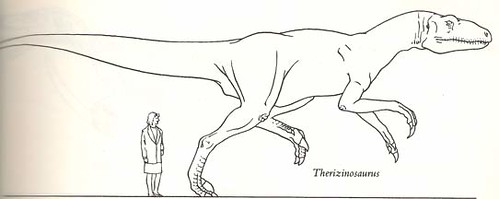[I will probably source a lot of this later, but this is what I wrote in response to Phylogenic Charts. A similar post is available here. The chart is so difficult to read. The file name is even Dino-Chart-Small.jpg. He does not source the chart with anything other than the book title, Dinosaur Data Book. As far as I can tell, this is the bibliographical data.
Lambert, 1990. The Dinosaur Data Book. New York: Avon Books.
 |
| "The Dinosaur Data Book" (1990) p. 125 |
The book was later reprinted in 1998 with somewhat of an update.[1] Also, I mention Therizinosaurus were not being mentioned. Apparently they are mentioned, but without complete skeletons they were thought to be carnivorous predators. Anyways, here it goes:]
"According to the chart, everything changed incredibly fast for 30 million years, then many didn’t change for the next 150 million years!"If I am reading your chart right, the numbers represent orders and clades of animals. The furthest to the right, #3, represents Crocodilians. Within that order, there are several families, genera, and species. "P" represents the famed long necked Sauropods which have many genera and species. If you were to zoom in on that infraorder you would find that evolutionists think they changed for the next 150 million years producing new genera and species. For example, lions are a species. Their genus includes tigers, leopards, and jaguars. Their family includes other cats like pumas and house cats. Their sub-order, Feliformia, includes also hyenas, mongooses, meerkats, etc... Their order, Carnivora, includes bears, seals, dogs, etc... It is misleading to say that the order of Crocodilians did not change when an order or infraorder contains a lot of diversity. Just look at "W" which represents the suborder Ceratopsians. They were both bipedal and quadrupeds.
Also, your chart was published in the "Dinosaur Data Book". When was it printed? The edition I found was printed in 1990, about 22 years ago. Has there been any more fossil evidence since then?
You quoted from What Evolution Is. If you continued the quote you would have noticed that he said:
The discovery of unbroken series of species changing gradually into descending species is very rare.He then points out that fossilization is rare and most fossils remain buried, because they are not close enough to the surface. He does not seem to “support” your conclusion. His book is available on Scribd if you think that I am wrong on assessing his point of view.
http://www.scribd.com/doc/43553720/Ernst-Mayr-What-Evolution-is-Copy
The other book review that you cite also does not seem to support your conclusion since he is speaking in more a historical context.
May I ask, what is your view point? You point to this chart as evidence that “one thing, stayed one thing and never changed into anything else! What we see in the world today and what we read in the Bible is consistent and true.” As already mentioned “W” is Ceratopsians. Do you hold that transitioning from a biped to a quadruped is not changing? “O” is Prosauropods and “P” is Sauropods. Do you hold that quasi-quadruped prosauropods transitioning into sauropods is changing? If “W” is OK, then why is “O” to “P” not OK?
Your chart, which again I assume is from around 1990 says, “j-m are flesh-eaters collectively called therapods”. This statement is out of date. In the mid-90’s a feathered herbivore therapod clade was discovered called Therizinosaurs. They belong to “m” on your chart, the clades “Carnosaurs and Coelurosaurs”. Therizionosaurs, are in the clade, Coelurosaurs, and all posses sloth like giant claws. How can “m” which represents two parallel clades teach that “one thing stayed one thing”? Also, how is anything becoming a Therizinosaur not becoming a new thing?
Lastly #6 is birds. Does this prove that God created the Class Birds as “one thing stayed one thing and never changed into anything else”?
You said, “The fossil record actually contains things that are dated back to 400 million years and they are exactly the same as what we see today!” Are you talking about the Coelacanth genus Latimeria? There is no fossil record for the specific genus Latimeria. There is a fossil record for the order Coelacanth.
PS ~ The text on the chart reads:
Ruling reptiles. This family tree shows the likely evolution of dinosaurs, birds, crocodilians and pterosaurs from within the mixed group of early archosaurs called thecodonts. For explanations of names see chapters 2 and 3. A Triassic Period. B Jutassic Period. C Cretaceous Period. 1 Armored archosaurs. 2 Thecodonts. a Proterosuchians. b Erythrosuchids. c Rauisuchians. d Aetosaurs. e. Phyosaurs (alias parasuchians). f Ornithosuchids. g Euparkeriids. h Lagosuchids. 3 Crocodilians. 4 Pterosaurs. 5 Dinosaurs. i Herrerasaurs. 5A Saurischian dinosaurs (j-m are flesh-eaters collectively called theropods). j Deinonychosaurs. h Oviraptorosaurs. m Carnosaurs and coelurosaurs. n Segnosaurs. o Prosauropods. p Sauropods. 5B Ornithischian dinosaurs. q Fabrosaurids. r Scelidosaurs. s Stegosaurs. t Ankylosaurs. u Ornithopods. v Heterodontosaurids. w Ceratopsians. x Pachycephalosaurs. 6 Birds.
I still cannot read the dates. The Triassic is generally about 50 million years, but he says the chart has only 30 million years. My only explanation (without a legible copy of the chart) is that the chart begins with the emergence of dinosaurs in the mid-triassic.

No comments:
Post a Comment